Legal Funding Showdown: Crowdfunding vs. Traditional Finance
In the high-stakes world of litigation, legal funding is often the linchpin between justice delayed and justice delivered. Plaintiffs and legal teams routinely face the challenge of mounting significant legal costs—attorney fees, court filings, expert witnesses, and case preparation can all add up long before a verdict is ever reached. Traditionally, litigants have relied on loans, law firm contingency arrangements, or third-party institutional funders to finance their cases. But a new challenger has stepped into the ring: legal crowdfunding. With the power of online platforms and public engagement, crowdfunding offers a dynamic alternative to conventional financing models. But which path leads to the best outcome? This in-depth comparison breaks down the advantages and drawbacks of crowdfunding and traditional legal financing to help litigants and funders make informed, strategic decisions.
Setting the Stage: What Defines Legal Crowdfunding?
Legal crowdfunding is the practice of raising money from a large group of individuals, often online, to support a lawsuit or legal campaign. It can be donation-based—where contributors support a cause without expecting a return—or investment-based, where backers share in the proceeds if the case succeeds. This model allows plaintiffs to tap into social support, generate awareness, and in some cases, build massive public pressure behind their legal actions. Platforms focused on legal crowdfunding have emerged with specific frameworks tailored to handling sensitive legal information, escrowed funds, and case updates.
The real appeal of crowdfunding lies in its democratizing force. It enables plaintiffs who might otherwise be shut out of the legal system due to lack of capital to gain access to resources through collective backing. It also allows funders, whether motivated by ethics or potential profits, to directly participate in the justice process in a way that was previously inaccessible.
The Established Option: Understanding Traditional Legal Financing
On the other end of the spectrum lies traditional legal financing. This includes pre-settlement funding provided by specialized litigation finance firms, law firms working on contingency, and in some cases, private lending. These models are often underpinned by formal underwriting processes, risk analysis, and detailed legal evaluations. Legal finance firms may advance capital to cover litigation costs in exchange for a portion of the case’s settlement or award, but they typically maintain strict control over how those funds are disbursed and expect a defined return.
Traditional financing is typically reserved for cases with clear liability and high settlement potential. Funders conduct due diligence on everything from legal counsel to jurisdiction before agreeing to fund a claim. In doing so, they offer a more stable, predictable funding structure—but not necessarily one that is inclusive or adaptable to all cases.
Accessibility and Inclusivity: Who Gets Funded?
Perhaps the most glaring distinction between crowdfunding and traditional financing is accessibility. Crowdfunding platforms are open to almost anyone. Whether you’re an underdog tenant taking on a negligent landlord, a civil rights activist filing suit against a municipality, or a small business battling a corporate giant, you can start a crowdfunding campaign. The barriers to entry are low, and the public becomes the gatekeeper, choosing which stories to support.
In contrast, traditional legal funding is highly selective. Funders only finance cases that meet stringent criteria, often focusing on commercial disputes, mass torts, or high-value personal injury claims. Plaintiffs with weaker credit, uncertain legal grounds, or smaller cases are unlikely to qualify. While this selectiveness protects funders, it also means many valid claims go unfunded. For plaintiffs outside the mold, crowdfunding may be their only viable financial path to the courtroom.
Speed and Timing: How Quickly Can You Secure Support?
Time is often critical in litigation. Legal battles move fast, and waiting for funding can mean missed deadlines, stalled momentum, or mounting pressure to settle prematurely. Crowdfunding offers the benefit of immediacy. Once a campaign is live, plaintiffs can begin receiving contributions in real time. Some platforms disburse funds incrementally as milestones are met, allowing plaintiffs to manage expenses on the fly.
Traditional legal funding, while generally more structured, can take significantly longer. Funders must conduct legal reviews, request documentation, assess case law, and sometimes negotiate with attorneys or courts before capital is released. The process can take weeks or months, especially for complex claims. However, once secured, traditional funding offers a lump sum or pre-approved structure that eliminates the uncertainties of donation flow.
Control and Autonomy: Who Steers the Case?
One of the most valuable aspects of litigation is control—particularly, the right of the plaintiff and attorney to decide the course of action. In donation-based crowdfunding, this control remains largely intact. Backers do not typically influence legal strategy. Even in investment-based crowdfunding, most platforms structure participation in a way that limits funder involvement to return expectations, rather than litigation decisions.
With traditional legal finance, the situation can be more nuanced. While funders are not supposed to interfere with legal judgment, their financial stake can sometimes exert soft pressure. In some cases, funders may push for early settlement or advise against certain legal moves if they believe the financial risks outweigh potential rewards. While most funders operate ethically, plaintiffs must carefully read funding agreements and ensure that legal autonomy is protected.
Public Exposure vs. Privacy: A Crucial Tradeoff
Crowdfunding thrives on storytelling. To rally support, plaintiffs must often make their cases public—sharing names, timelines, injuries, or injustices in vivid detail. This exposure helps raise money, but it comes with risks. It may affect jury pools, open plaintiffs to public scrutiny, or inadvertently reveal case strategy. Crowdfunding also leaves a digital footprint that may persist long after the legal matter is resolved.
Traditional legal finance, by contrast, operates quietly. Confidentiality is preserved, and sensitive case information is shared only with the funder and legal counsel. This can be essential in matters involving trade secrets, reputational concerns, or private conflicts. For plaintiffs who value discretion—or whose legal team advises caution—traditional financing provides a shield that crowdfunding simply can’t match.
Financial Structure and Costs: What’s the Price of Support?
Both crowdfunding and traditional legal funding come with financial implications, but they differ significantly in structure. In donation-based crowdfunding, the money raised is generally treated as a gift—there is no obligation to repay, even if the case is lost. Investment-based crowdfunding, however, requires plaintiffs to share a percentage of any settlement or award with backers, with terms negotiated upfront.
Traditional legal funding almost always involves repayment plus fees or a share of the recovery. These agreements can be expensive, with effective interest rates or return caps significantly reducing the plaintiff’s final compensation. Still, the structured nature of these deals gives plaintiffs a clear understanding of their obligations. With crowdfunding, especially in the donation model, plaintiffs may retain more of their winnings, but the outcome is less predictable.
Emotional Momentum and Community Support
One area where crowdfunding shines is in building momentum and community. Legal battles can feel isolating, and crowdfunding provides emotional as well as financial reinforcement. Contributors often leave messages of support, media outlets amplify the story, and a larger movement can form around a single campaign. This communal energy can empower plaintiffs, energize legal teams, and even influence opposing parties to negotiate.
Traditional funding lacks this emotional component. While it may offer financial relief, it does not create a public platform or network of supporters. Plaintiffs who seek solidarity, validation, or advocacy may find crowdfunding far more fulfilling than a faceless financial transaction. In the most impactful cases, crowdfunding is more than funding—it’s a movement.
Investor Risk and Return Considerations
For funders, the risk-return profile is a defining factor. Investment-based crowdfunding offers potentially high returns, particularly when backing commercial cases or high-value claims. However, the risks are substantial. If the case is lost or dismissed, the investment may be lost entirely. Unlike traditional funders, crowdfunding investors typically have less access to in-depth legal analysis, limited control, and fewer protections.
Traditional legal finance firms, on the other hand, employ legal teams, risk analysts, and underwriting models to minimize losses and maximize returns. Their scale allows them to weather losses and seek portfolio-wide profitability. For individuals seeking to invest in legal outcomes, crowdfunding platforms offer access but require greater caution and due diligence. For institutions or risk-averse investors, traditional channels offer more predictability and structure.
Future Outlook: Innovation on Both Fronts
Both crowdfunding and traditional legal financing are evolving. Crowdfunding platforms are beginning to offer hybrid models, smart contract-based investment agreements, and better case tracking tools. Traditional funders are expanding their reach, exploring smaller claims, and incorporating tech to speed up due diligence. In the future, the lines between the two models may blur. Platforms might offer private crowdfunding channels with vetting similar to institutional finance. Legal funders may begin partnering with crowd platforms to co-fund or syndicate opportunities.
As legal funding continues to attract attention, both models will be forced to innovate, compete, and adapt. Plaintiffs will benefit from increased options, more competitive terms, and faster access to capital. Funders will enjoy more transparency, better legal data, and new markets to explore. The future of legal finance will likely be hybrid, inclusive, and deeply tech-enabled.
The Verdict: Choosing the Right Path
In the battle of crowdfunding versus traditional legal financing, there is no single winner—only the option that best suits your case, your goals, and your values. If you’re looking for broad support, rapid exposure, and flexible funding with minimal strings attached, crowdfunding is a powerful option. It’s ideal for socially resonant cases, individual plaintiffs, and early-stage campaigns where awareness matters as much as capital.
If you’re pursuing a high-stakes commercial dispute, need large-scale funding, or require privacy and structure, traditional financing may be the better route. It brings the backing of legal professionals, the confidence of due diligence, and the potential for sustained support throughout litigation.
Each path has its tradeoffs. Each path serves a different need. But for the first time in history, plaintiffs are not locked into one way of funding their fight. The power to choose—and to chart the course of justice—is finally in their hands.




